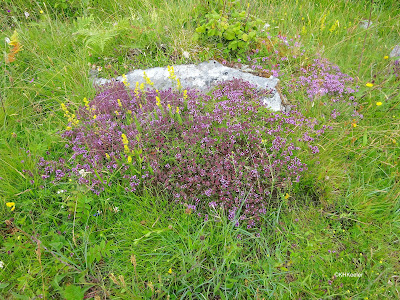In western Ireland, there is a region of limestone outcrops, called the Burren. Great expanses of limestone rock lie at the surface. You can see them as the hills in the distance in the photo. Plants grow in crevasses, but nothing grows on rock, so it has never been cropland.
 |
| The Burren on the hills in the distance |
Here you can get a slightly better sense of it. Big rocks in the foreground, and the gray that might elsewhere be standing water in the distance, is another area of bare limestone rocks.
Below is a more dramatic view
It was tricky walking if you ventured off the path.
The geology and hydrology of the region are very distinctive. The limestone makes the soil very alkaline as it dissolves, even in an area like northern Europe where conditions generally favor acidic soils. Furthermore, limestone is very porous, so rainwater seeps through it to the rocks below. The Burren has a moist, mild climate; 40-55 inches annually, summer highs not quite reaching 60oF and winter days in the lower 40o with frost uncommon, historically. Water lingers in cracks and pits, available to plants. Even in a period of drought or cold, the plants of the Burren tend to stay green. It has been excellent pasturage since humans arrived.
This photo shows the process: moisture or standing water in the small, dark gray, circular pit dissolves the rock, leaving an ever-bigger depression, gradually destroying the rocks. Grasses and other small plants fill in where dirt accumulates.
The odd soil conditions and lack of plowing make the Burren rich in wildflowers. Few of the plants are unique to the Burren but may be more easily seen than in other Irish or European meadows and pastures. Part of this region of limestone outcrops has been preserved as Burren National Park, created in 1991.
The name Burren is derived from the Irish boireann, a rocky place, so an obvious and descriptive name.
It is a very pretty place. I was there in July.
 |
| Burren scene |
The purple is wild thyme, Thymus polytrichus, (mint family, Lamiaceae), the yellow spikes are ladies' bedstraw, Galium verum (madder family, Rubiaceae).
 |
| wild thyme, ladies' bedstraw |
Yarrow, Achillea millefolium (sunflower family, Asteraceae), a very widespread plant with medicnal value (for example, the finely divided leaves reduce bleeding, and contain antiinflammatory and astringent properties).
 |
| yarrow, Achillea millefolium |
 |
| Ox-eye daisy, Leucanthemum vulgare, and flower-visitor |
 |
| bracken fern, Pteridium aquilinum |
 |
| O'Kelly's spotted orchid, Dactylorhiza fuchsii f, okellyi |
I'm not sure what these plants are, so just enjoy the photo
 |
The climate will support trees. However for centuries the Irish needed wood, so they cut many trees, steady grazing on the Burren inhibited tree regeneration and the English, occupying Ireland for 700 years, had a tree removal policy to reduce cover for Irish rebels, so for all those reasons, the Burren became a treeless plain. Today, the human population of the region has dropped and become less agricultural, so with less intensitive land use, letting shrubs and trees establish and grow.
Although there is a Burren National Park. much of the Burren is privately owned. For millennia, literally, the owners have maintained stone fences on their property lines. Not all are old--stone fences require continuous maintenance--but some are very old. I easily imagined generation after generation of Irish farmers walking their boundaries, rechecking and repairing the old stones walls.
A fascinating place
 |
| Wildflowers, the Burren, Ireland |
References
Nelson, C. 2023. The wild plants of the Burren and the Aran Islands. The Collins Press, Cork, Ireland.
Further reading: The geology of the Burren link
Kathy Keeler
A Wandering Botanist
More at awanderingbotanist.com
Join me on Facebook: https://www.facebook.com/AWanderingBotanist





Thanks for posting - looks like a beautiful trip to a fabled place. Always interesting to see plants that overlap with our Colorado flora. I think the five-petaled yellow wildflower is St. Johns wort. Maybe they used that for medicine too. - Mike K.
ReplyDelete